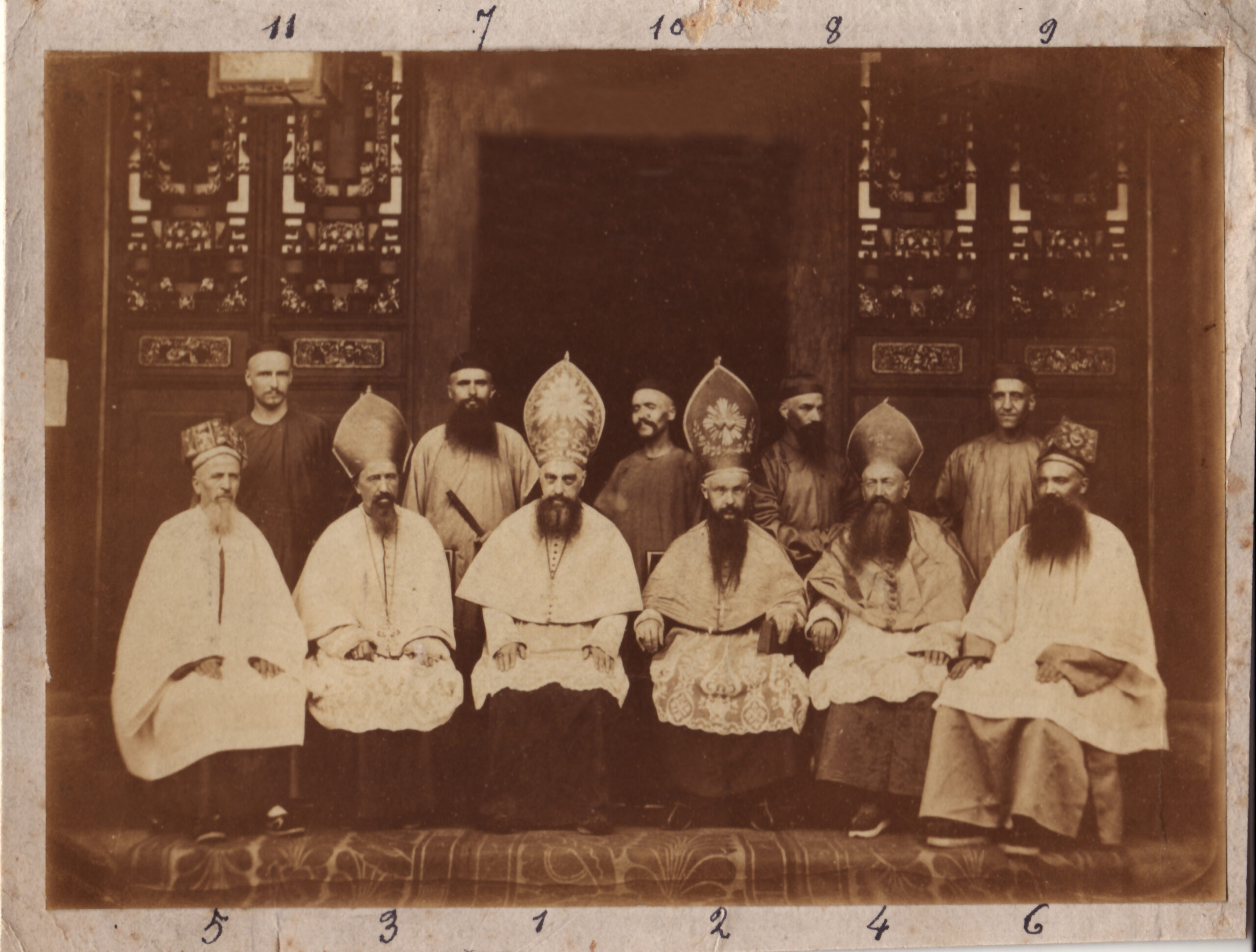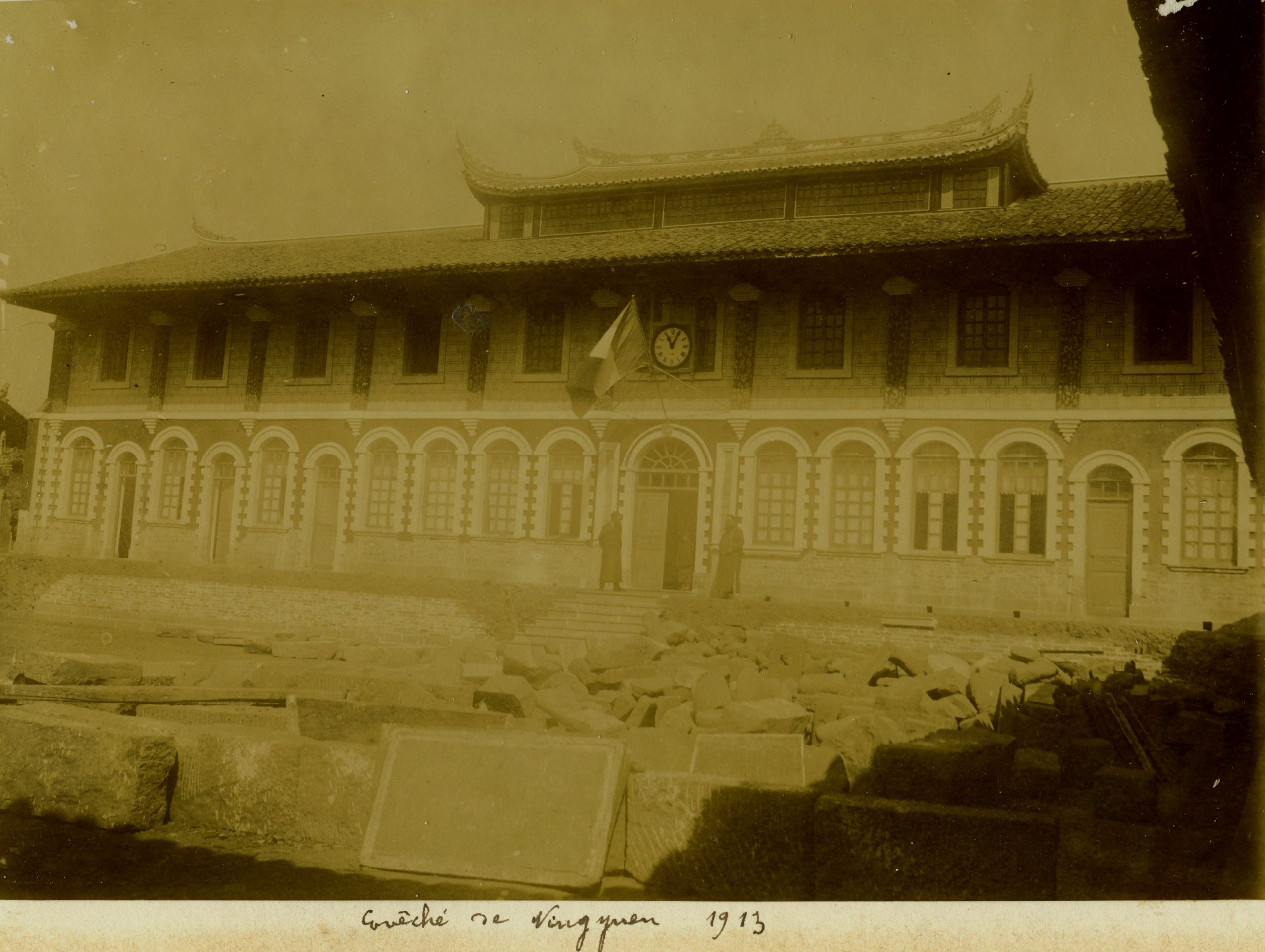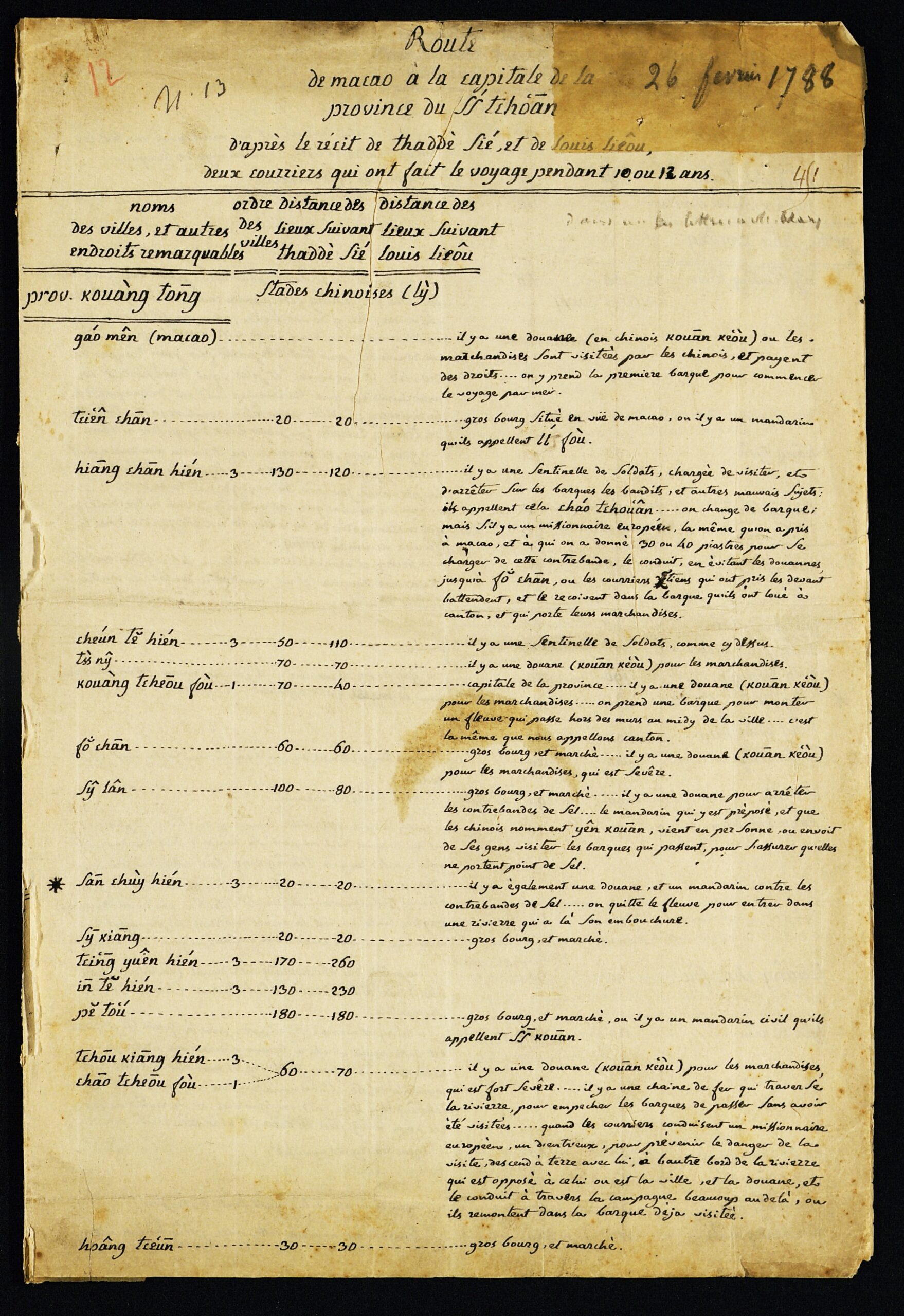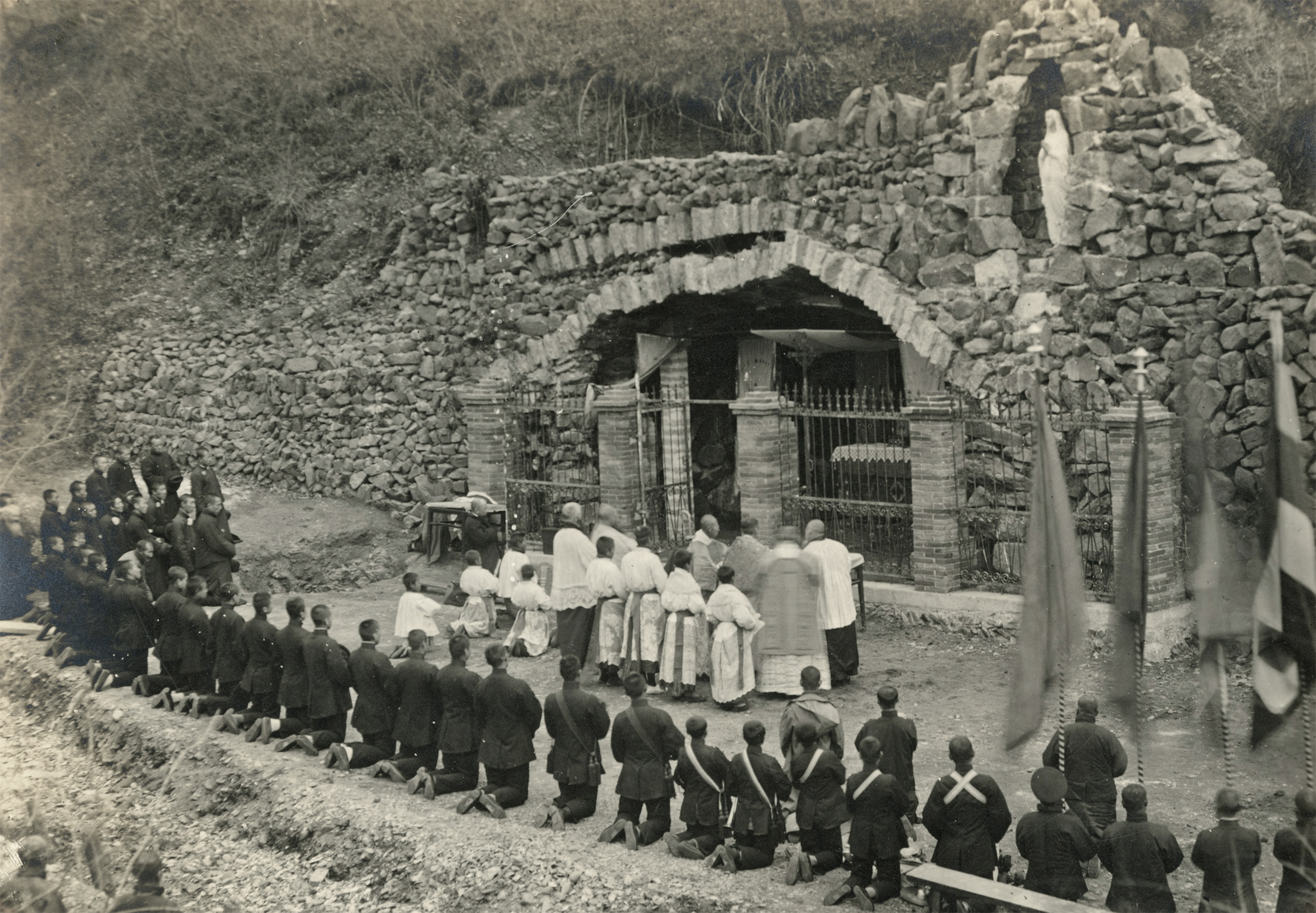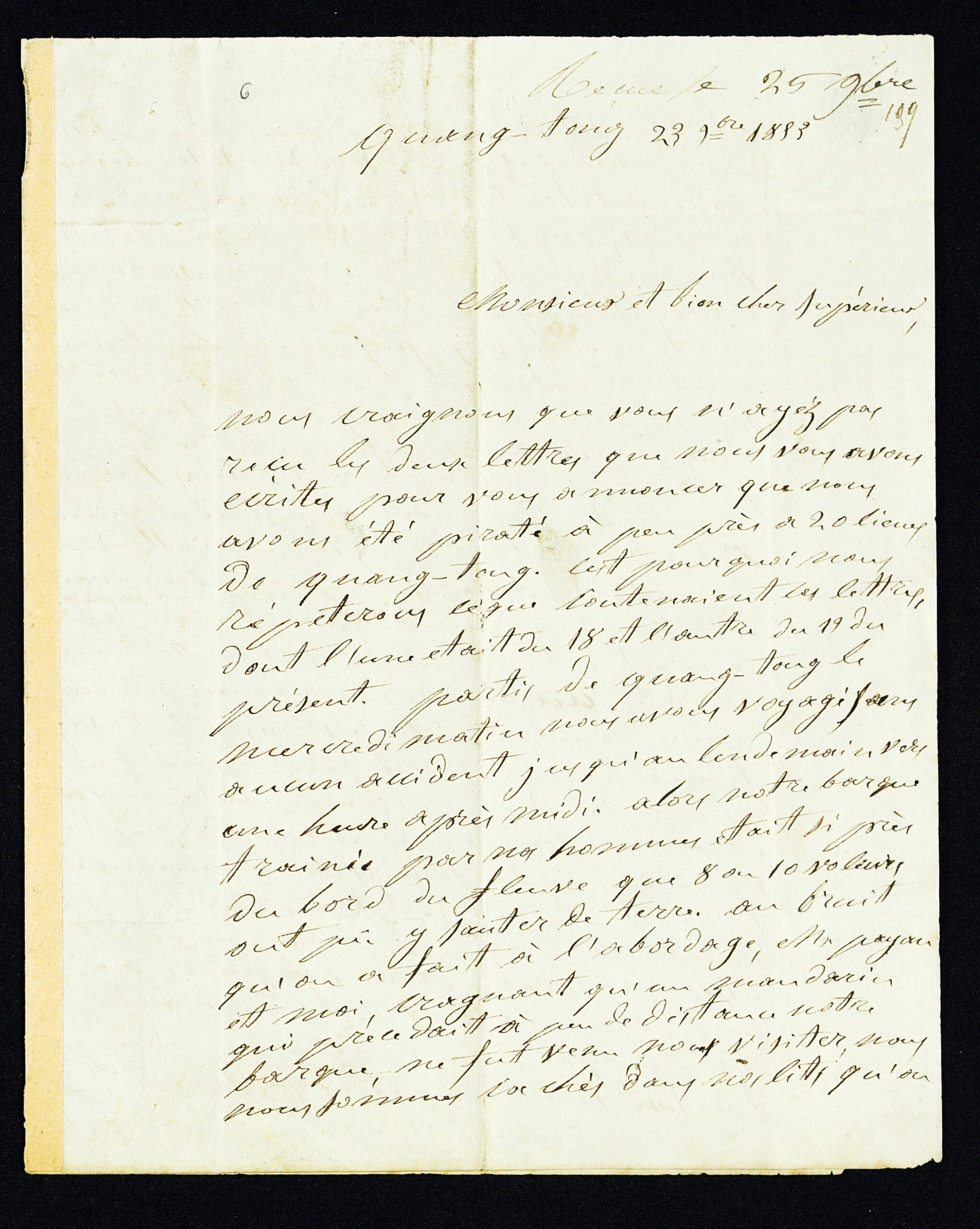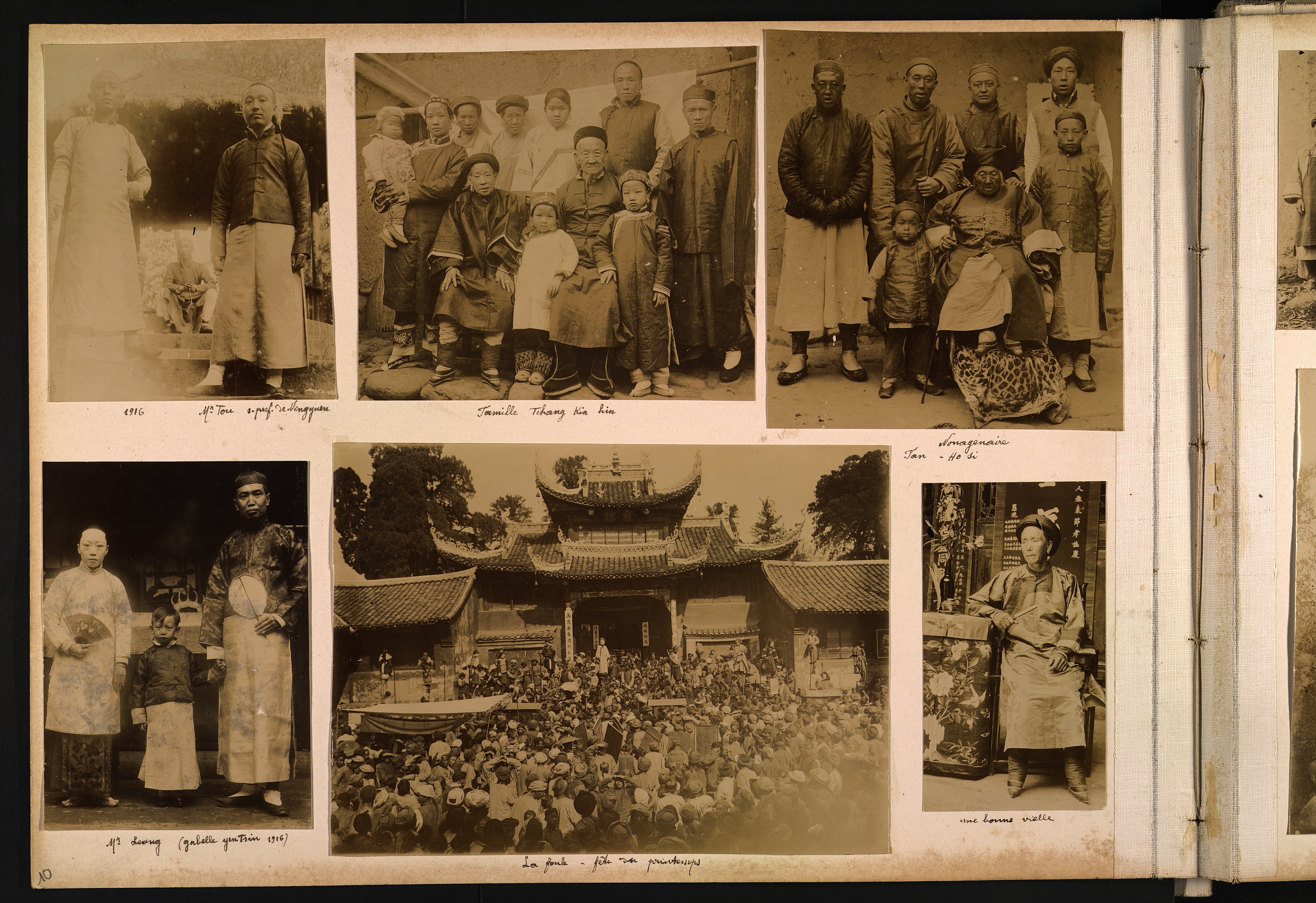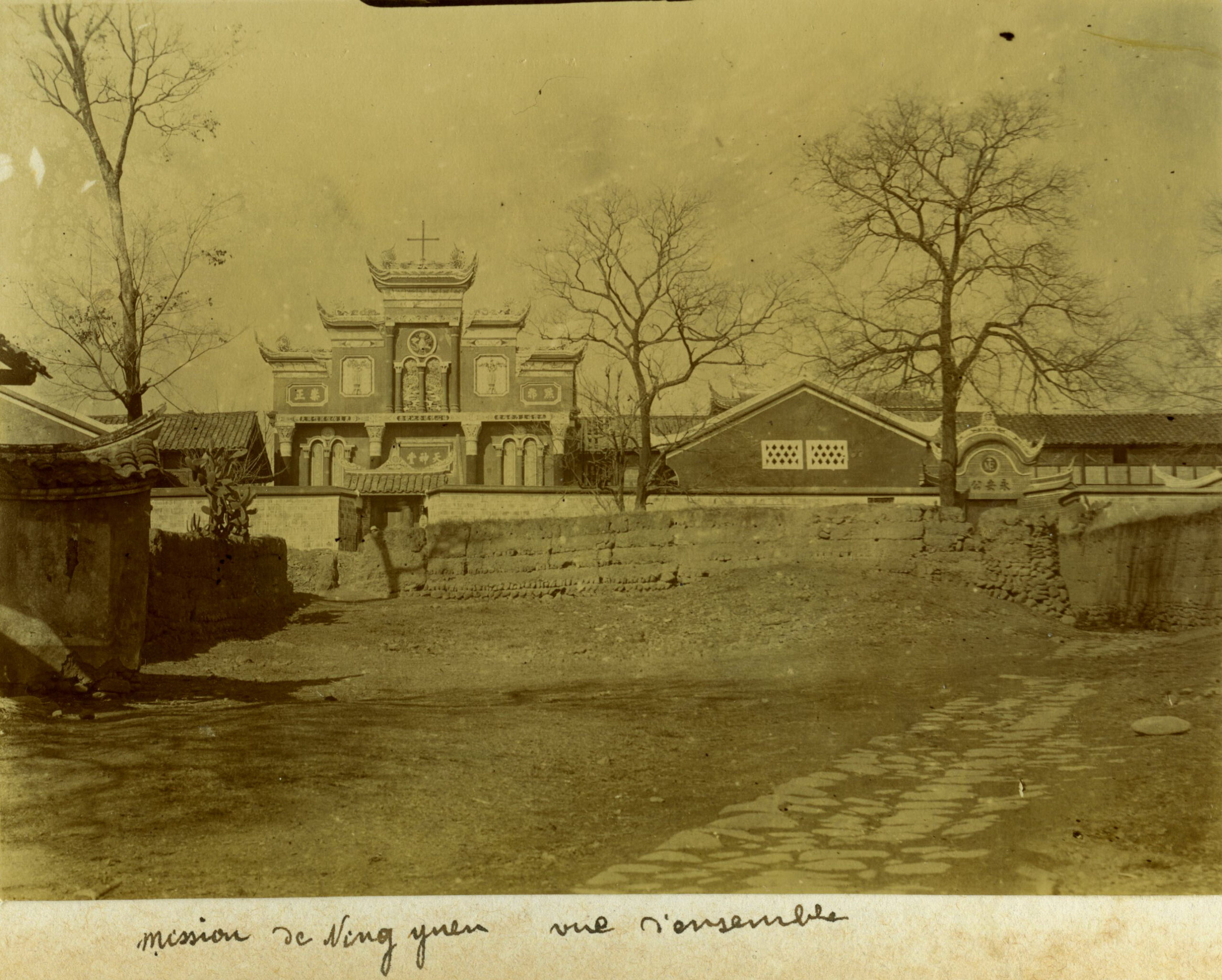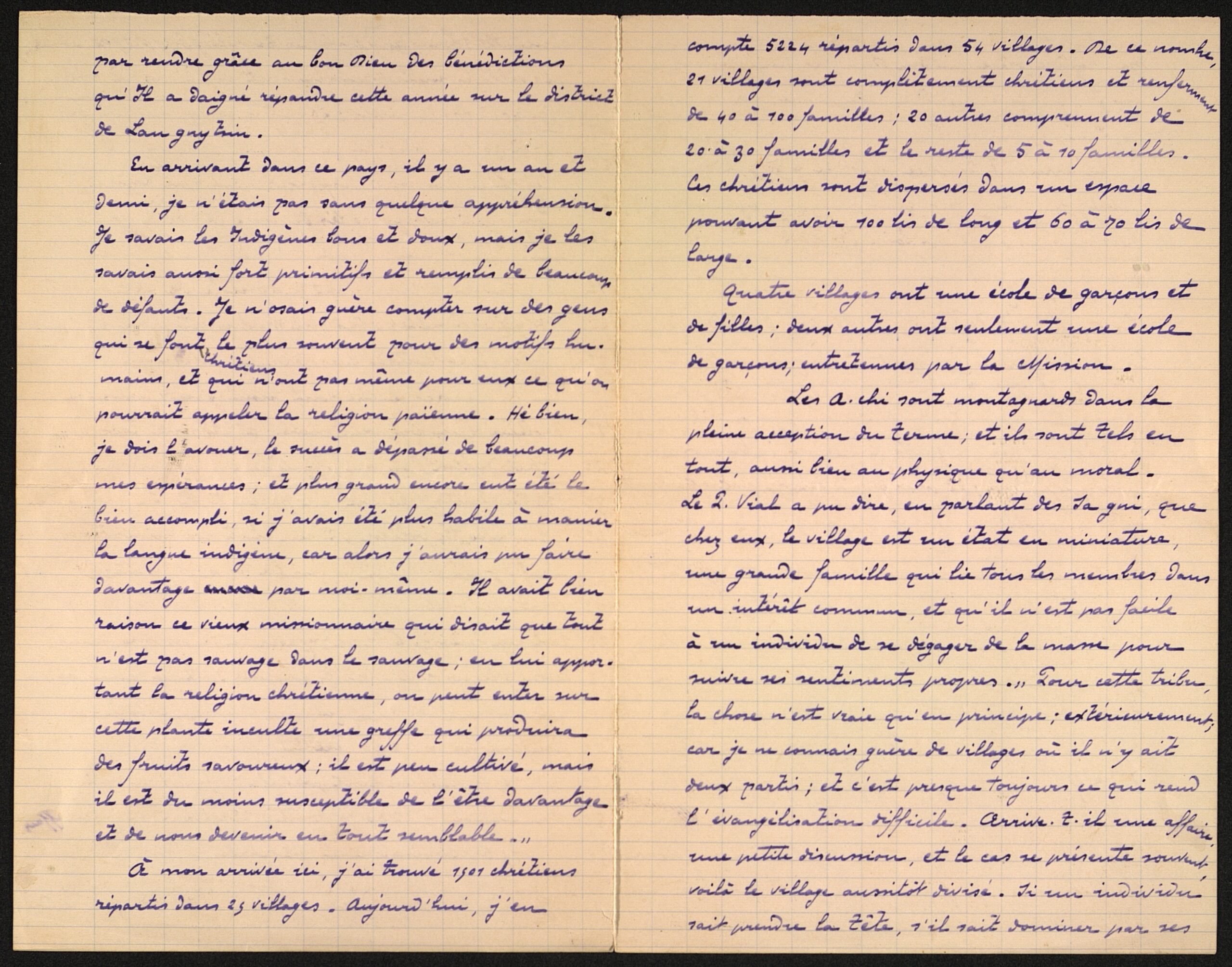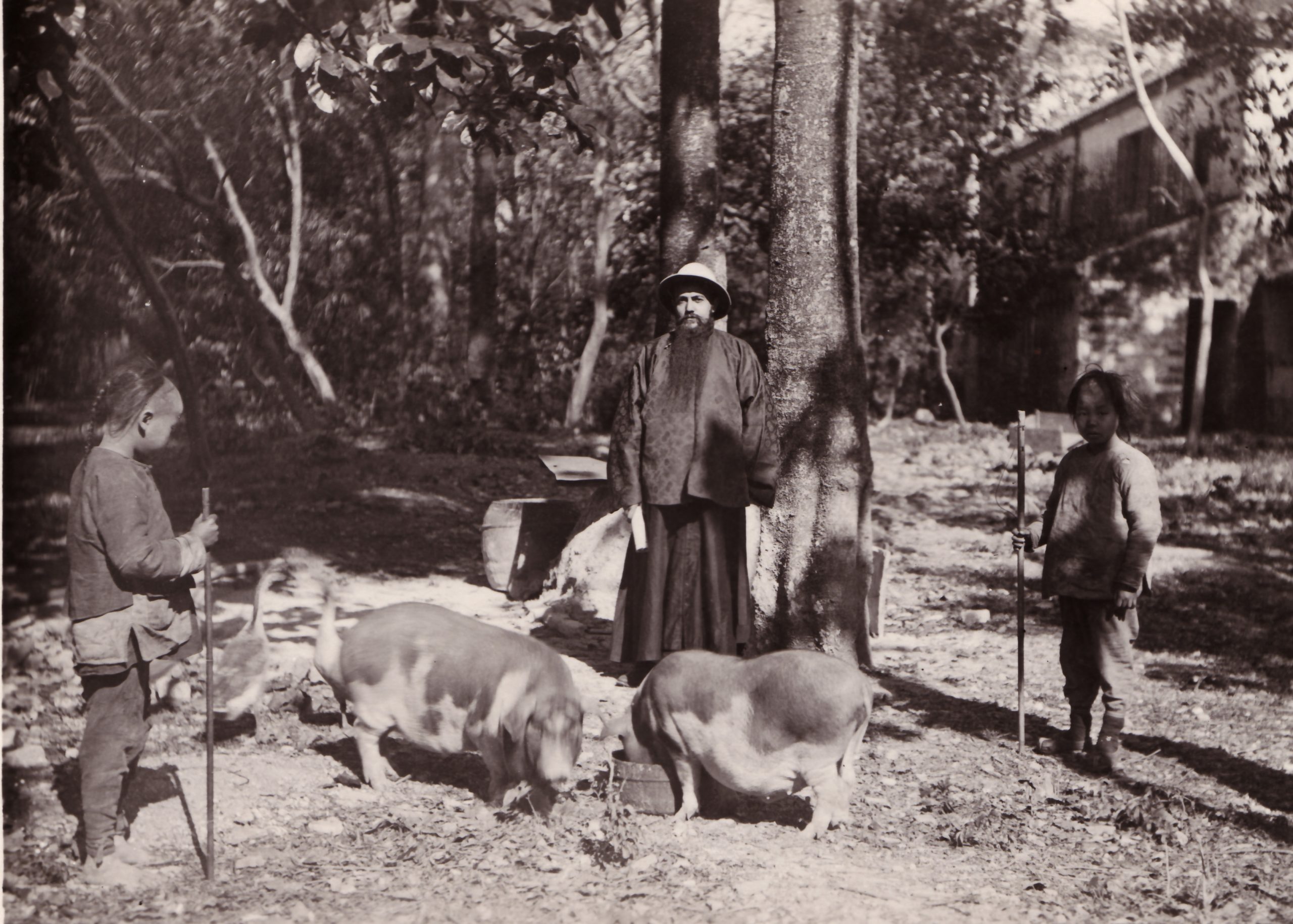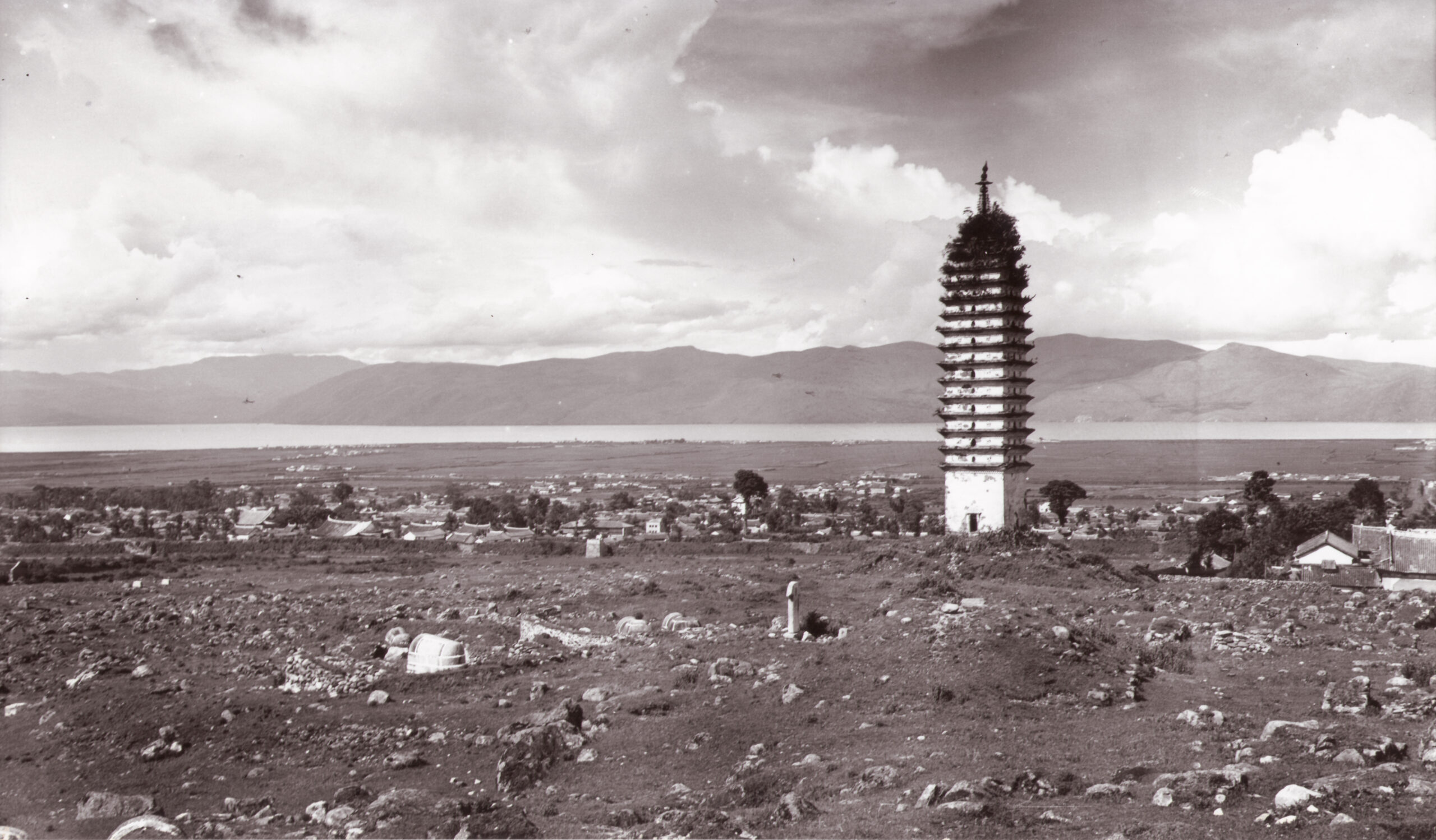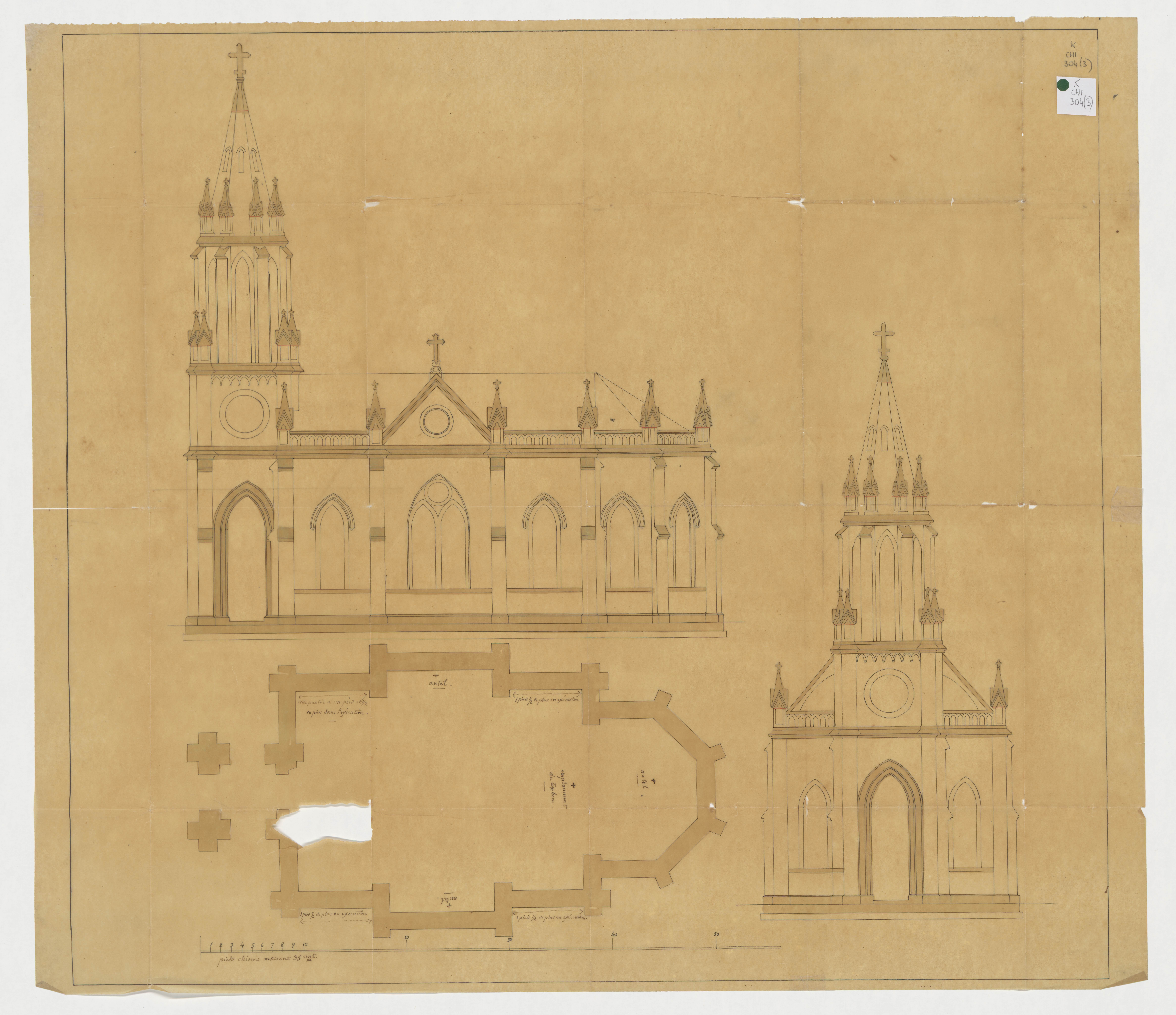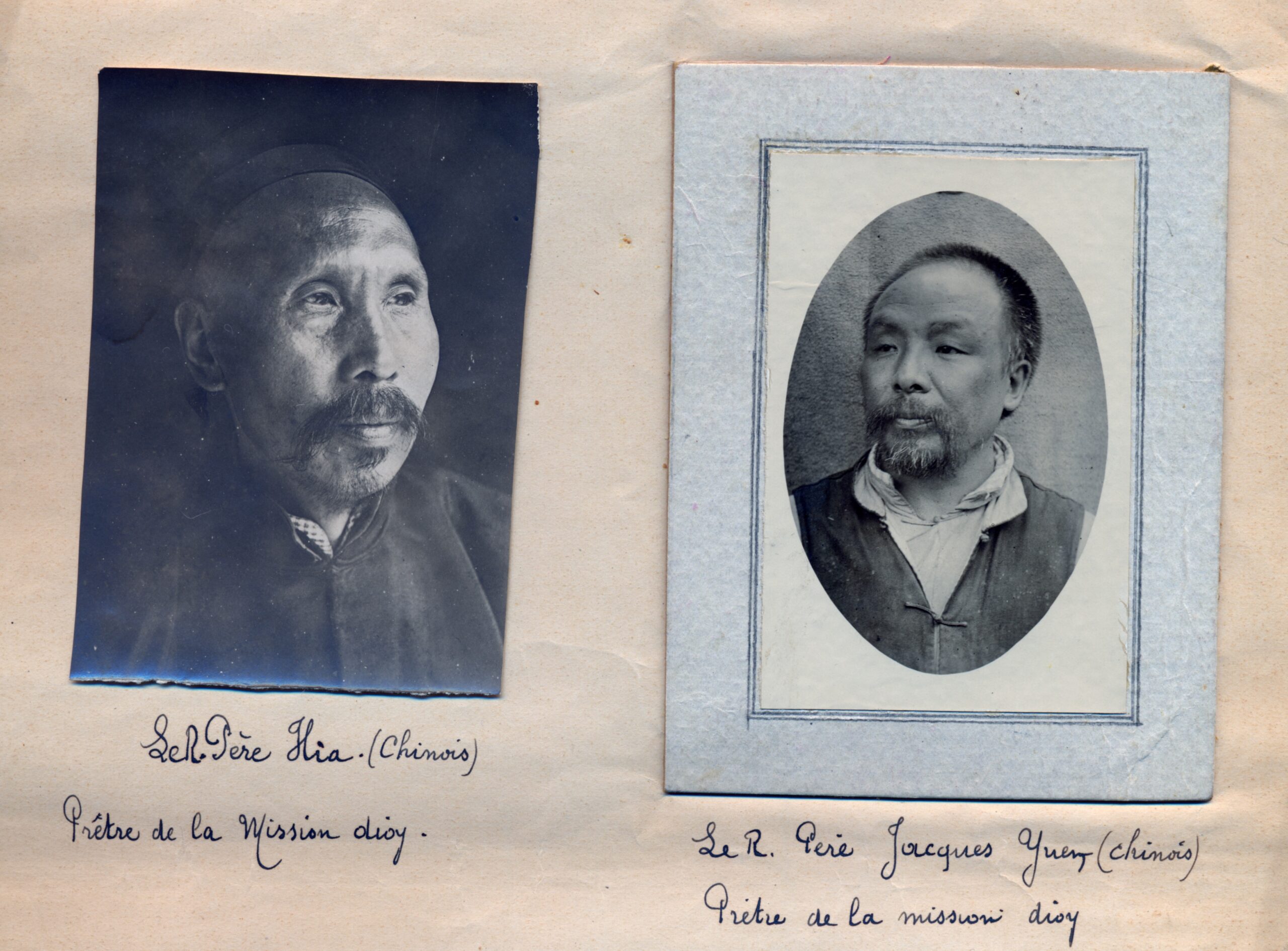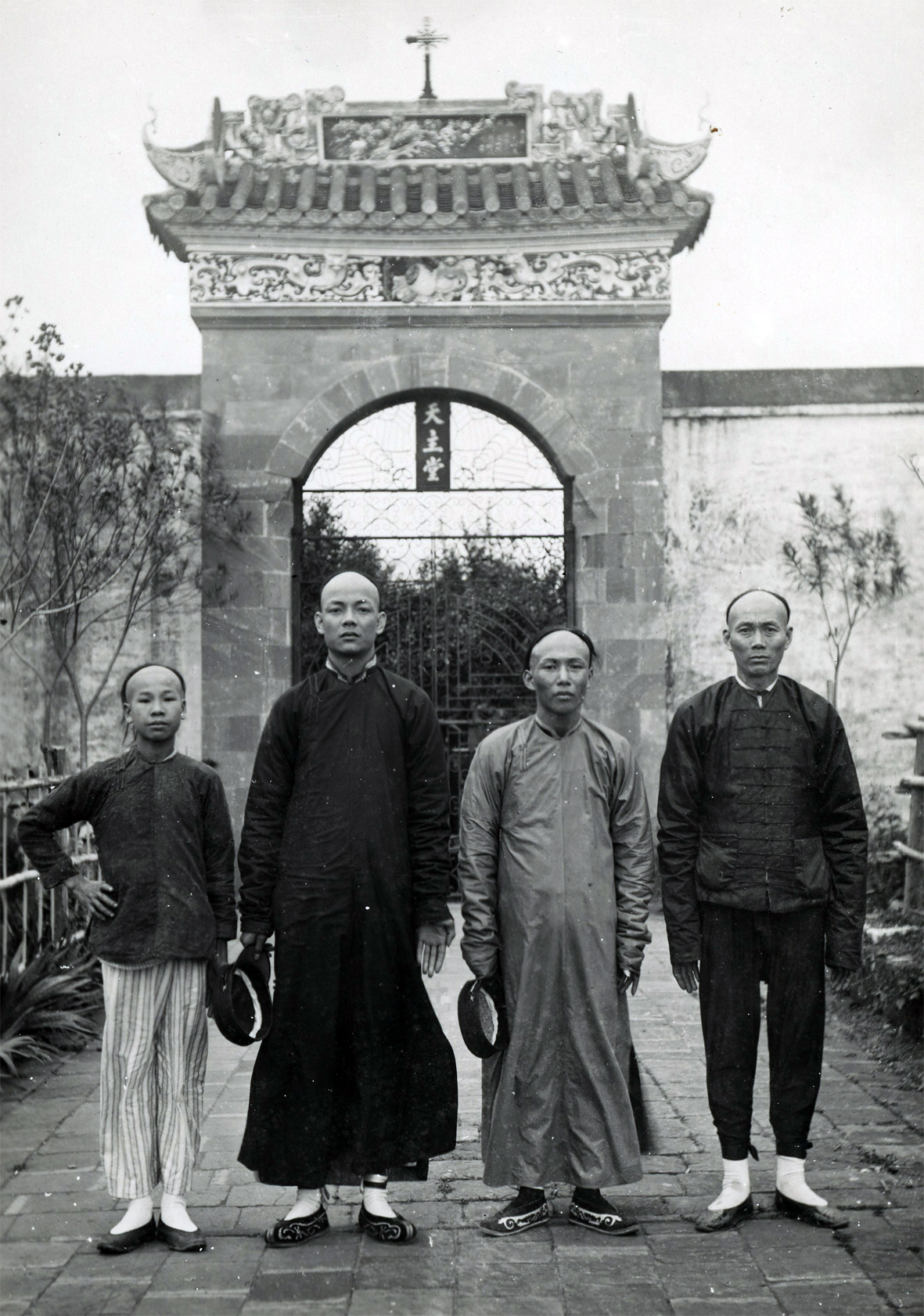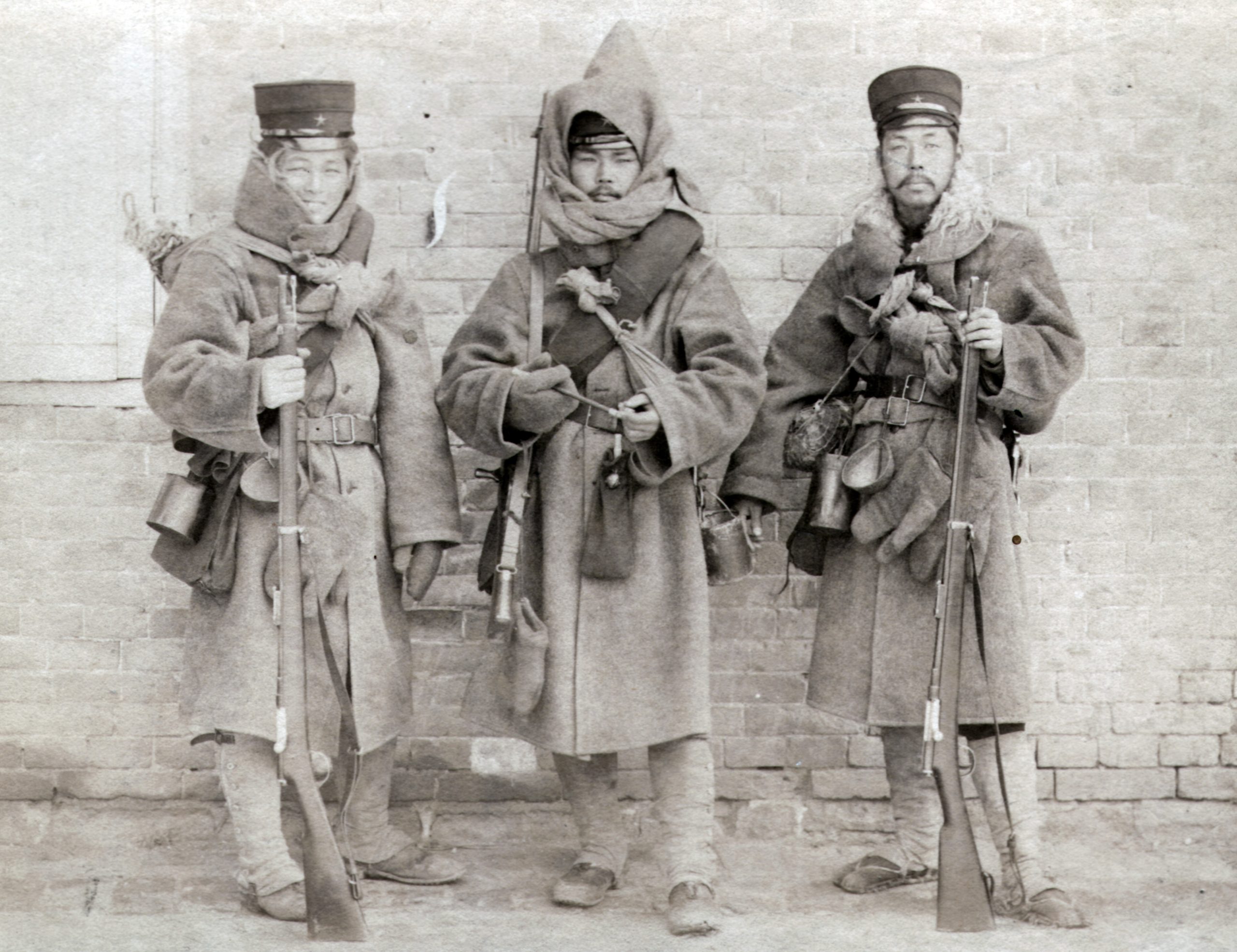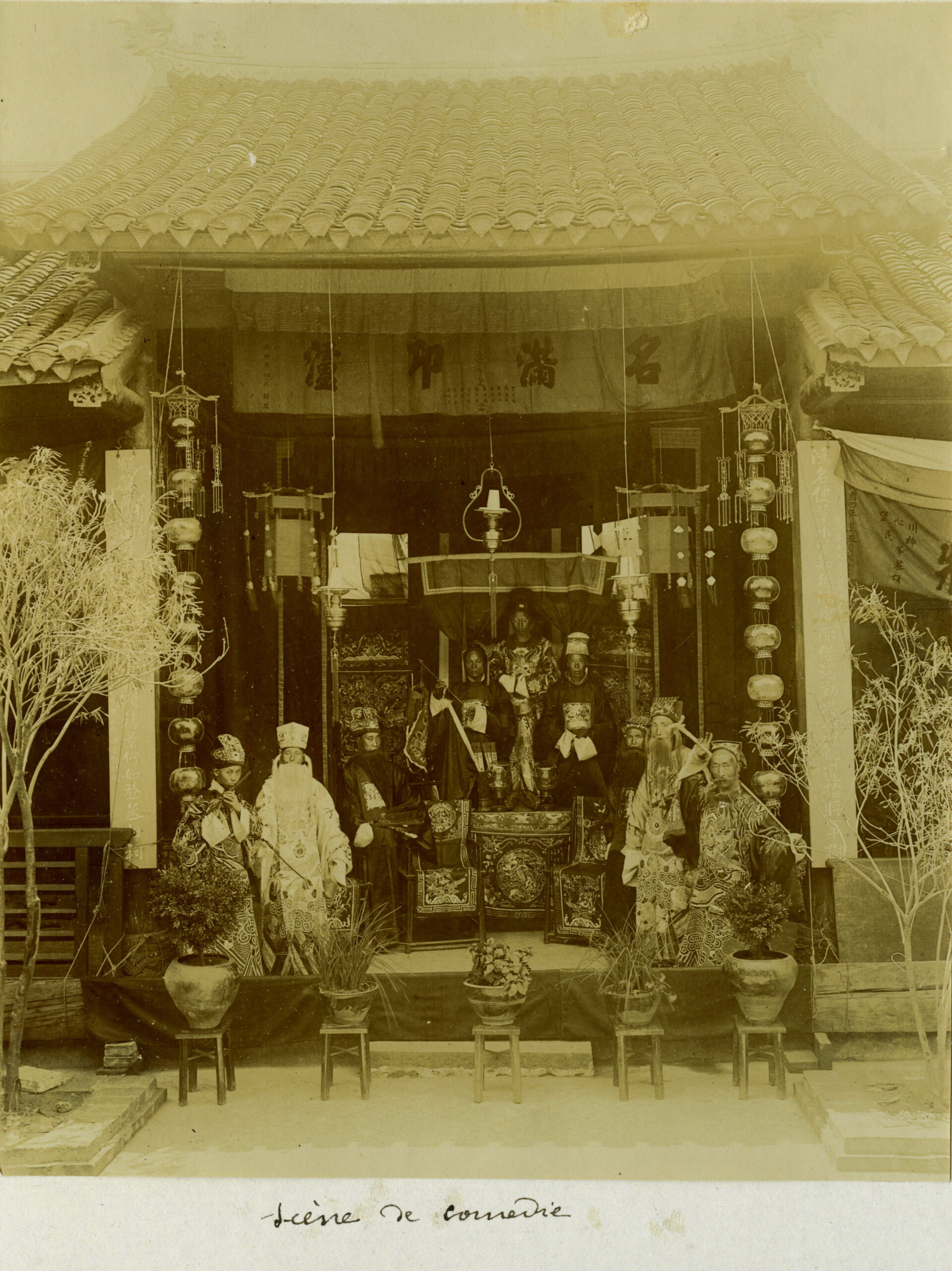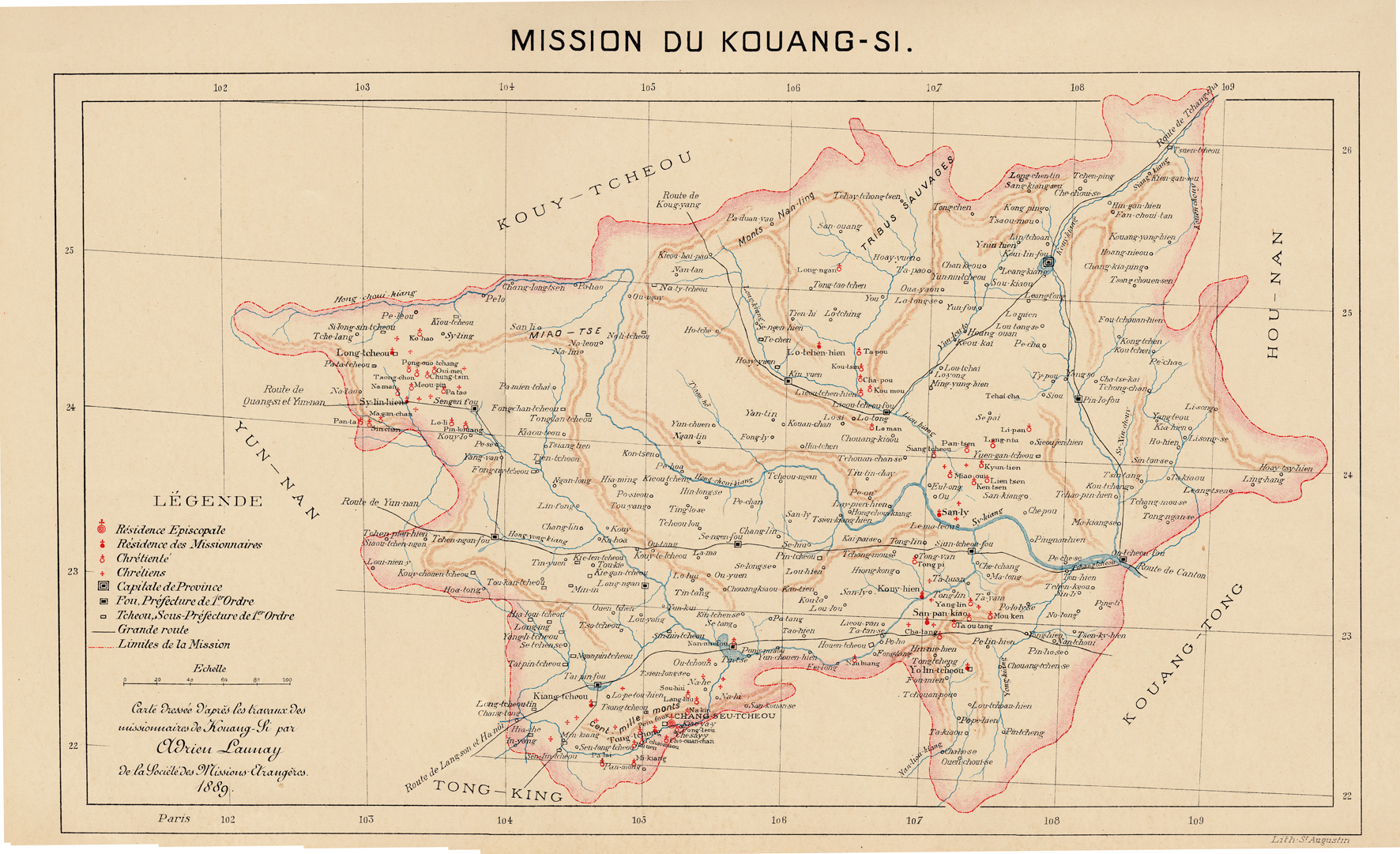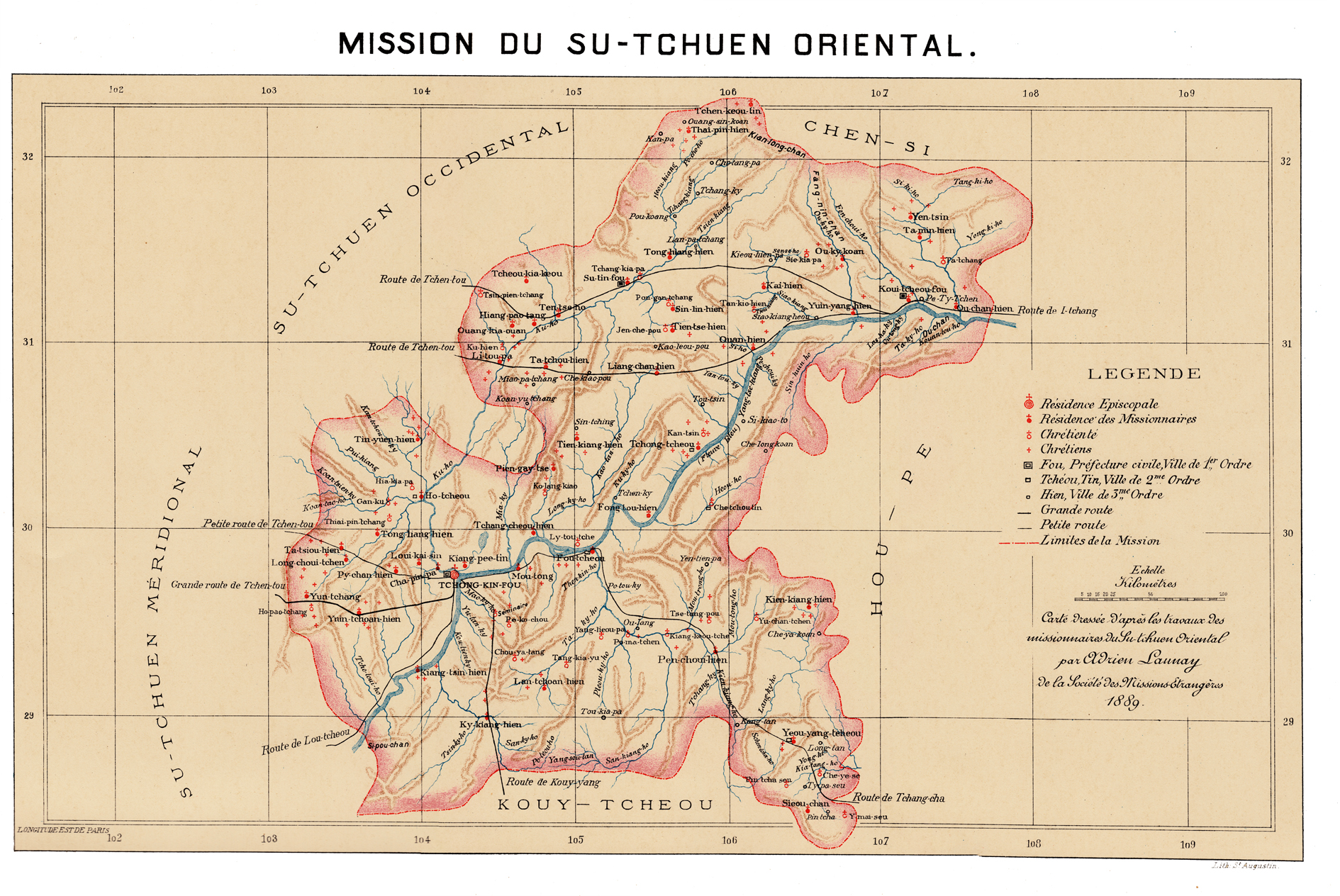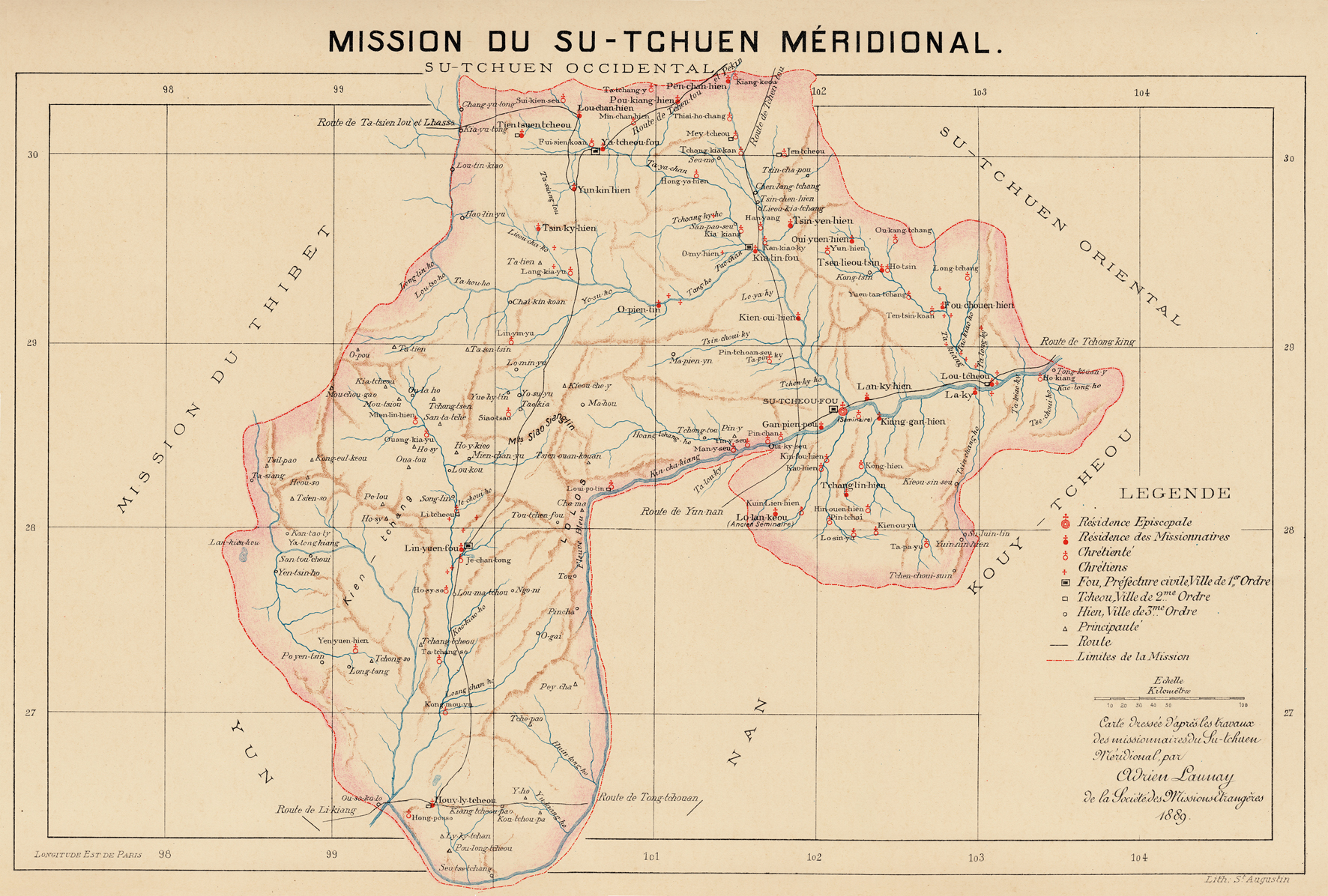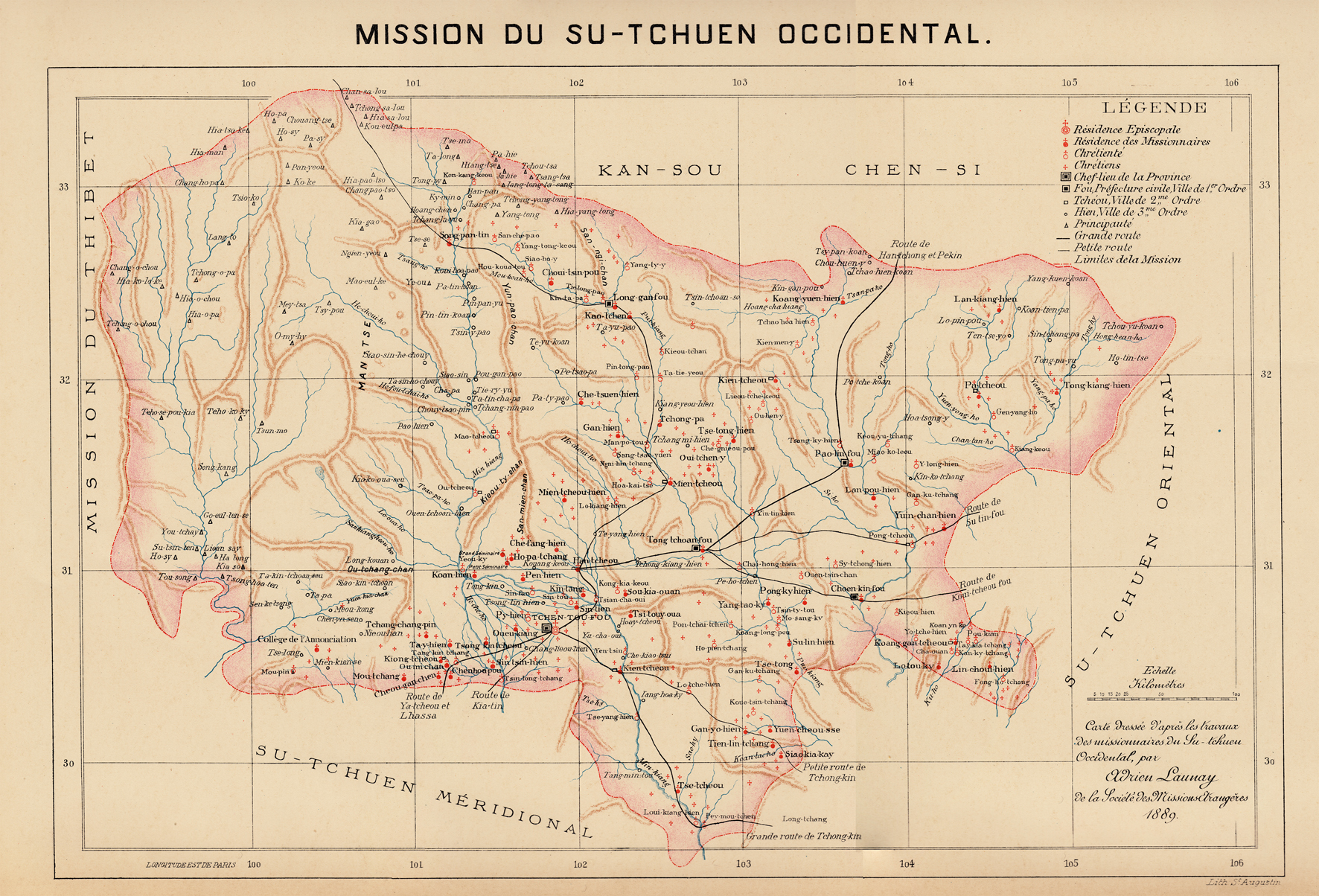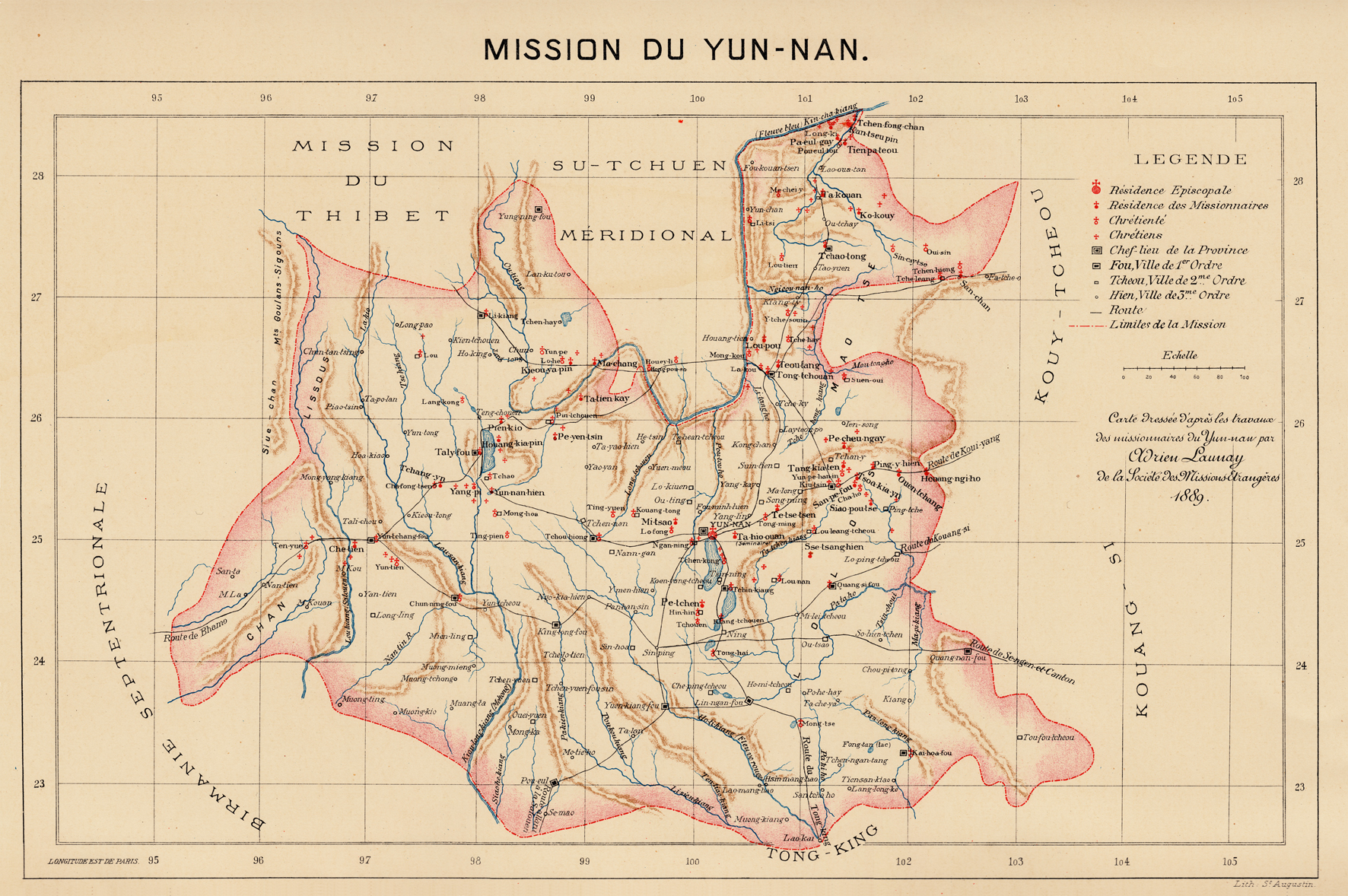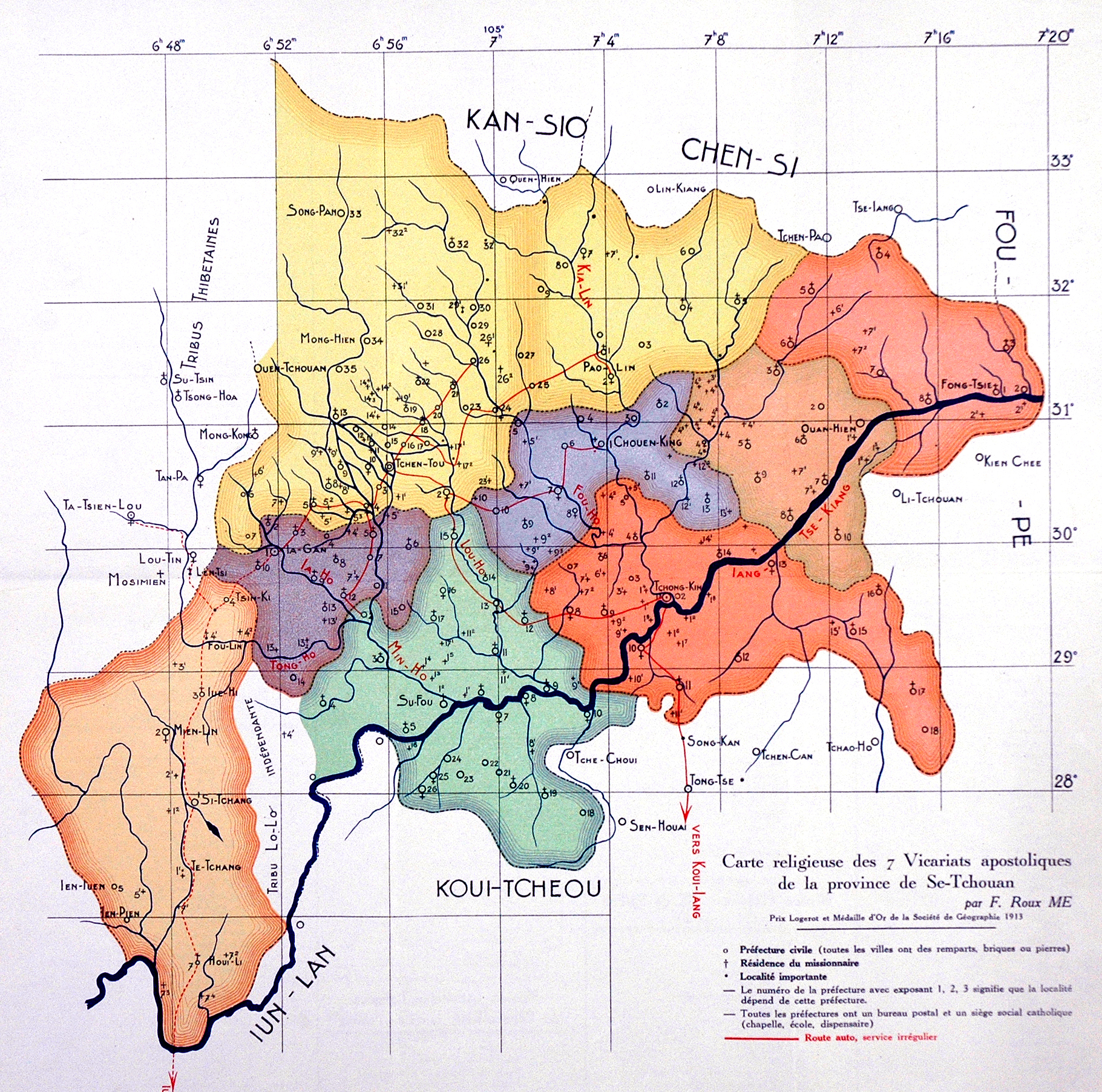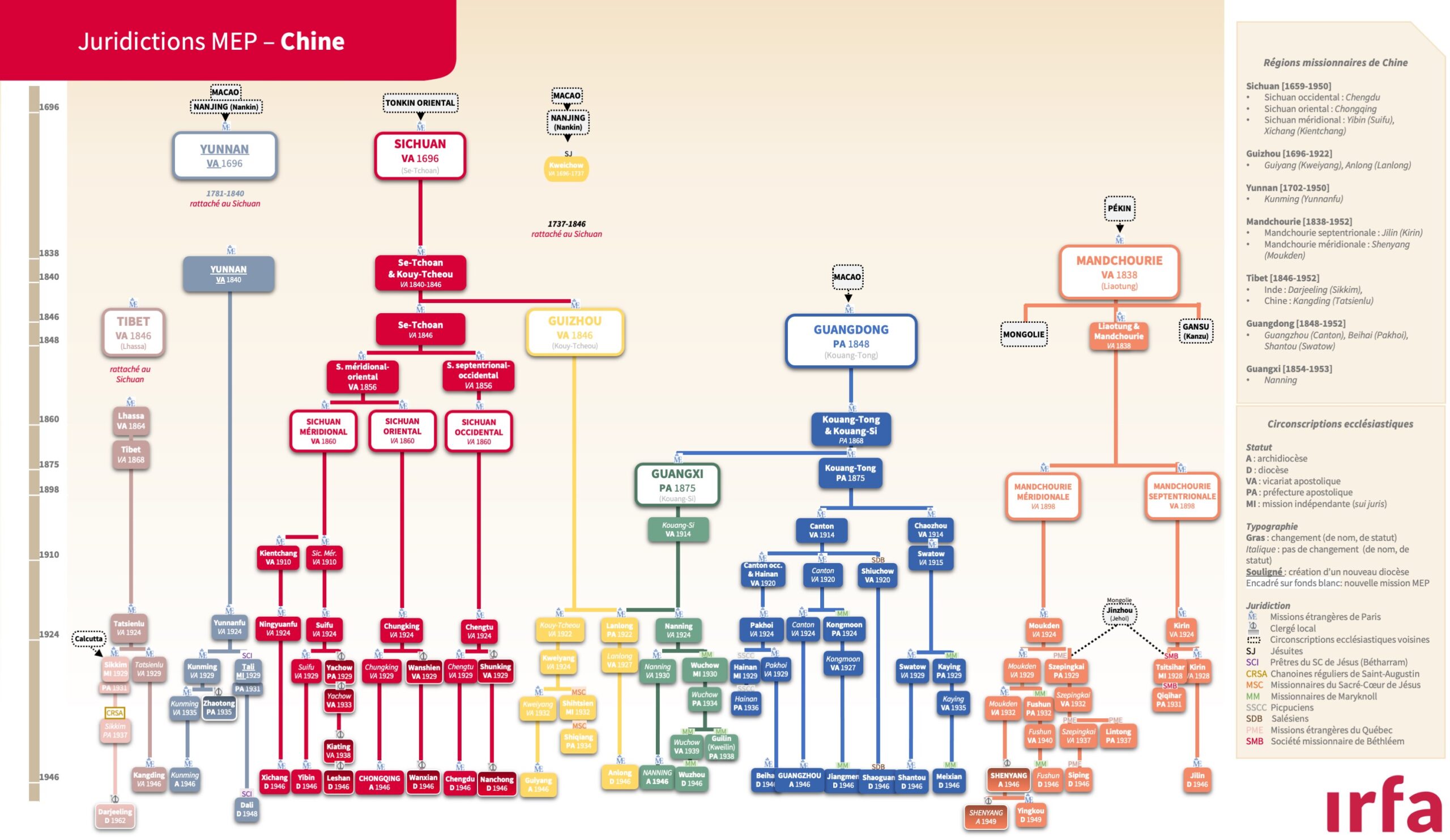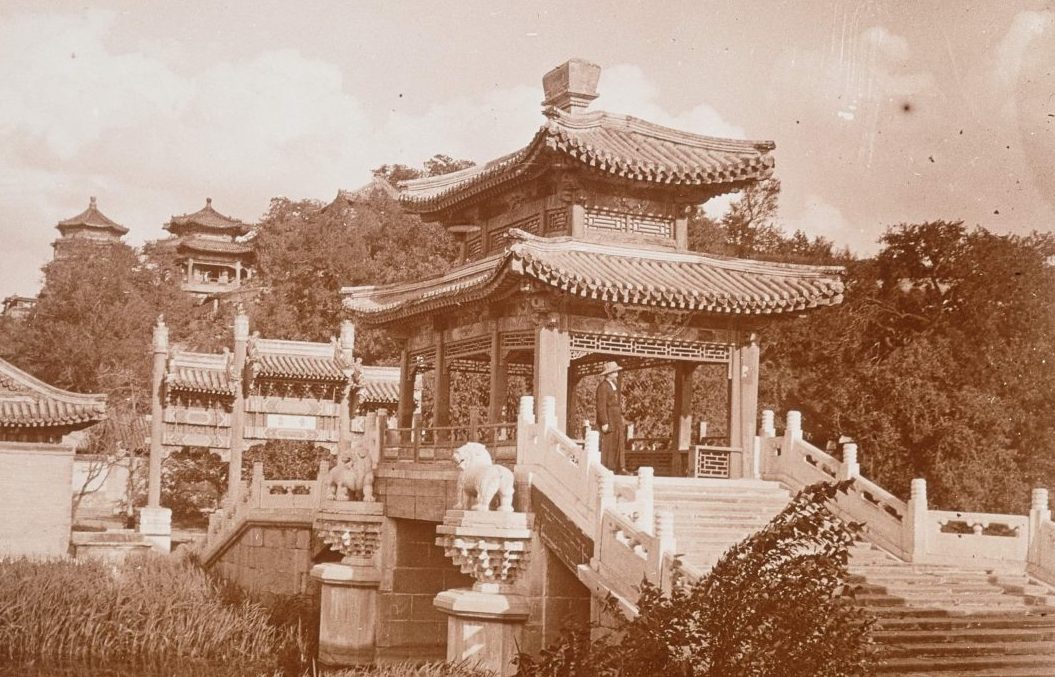
The MEP in China (1684-1955): an overview
During the sixteenth and seventeenth centuries, the arrival of the first European ships brings Christianity to the doorstep of a vast China. It is only in 1684 however, with Mgr François Pallu, that the MEP enter China for the first time. Their work is rapidly hindered by the effects of the “Chinese rituals quarrel”. From 1645 onwards and for more than a century, the quarrel involves great MEP figures such as Mgr Charles Maigrot, whose 1693 mandate revives heated debates. In 1696, the MEP are assigned the Sichuan and Yunnan apostolic vicariates by Rome. Despite the 1706 imperial edict demanding that every missionary respects the traditional Confucian rituals, the MEP secretly continue with their apostolate.
From 1715 (Ex illa die papal bull condemning the Chinese rituals) until the First opium war in 1840, the MEP missionaries are located primarily in the Sichuan and Yunnan provinces, where they rely on the colossal work of Chinese priests and catechists like André Li, handling their ministry despite the persecutions and the absence of subsidies from Europe. Many Chinese Christians will die as martyrs during the second half of the eighteenth century and the beginning of the nineteenth century.
From 1840 until the advent of the Republic of China in 1912, the colonial period brings about major changes as it allows for a relative acceptance of the Christian missionaries’ presence. However, because this presence is imposed through gunboat diplomacy from the European nations, the missionaries are met with a growing hostility inside the local populations. Despite the protection provided by unbalanced treaties, the missionaries, whose presence is associated with the invader, experience new persecutions. The martyr Auguste Chapdelaine (1842) is a perfect example.
Simultaneously, the missionaries explore uncharted territories, like Manchuria (assigned to the MEP by Rome in 1838) and Tibet (multiple attempts from 1846 onwards). They also widen their scope of action to the Guangdong (from 1848), Guizhou (1860), and Guangxi (1875) provinces. The human and financial resources required for their operations are to be found in the Macao/Hong Kong procure, the central hub of the missionary activities.
Between 1912 and 1949, China is dragged into a complex cycle of alliances and must face up to the aggressivity of its Japanese neighbour, whose incursions on Chinese territory are multiplying. The work of the MEP is therefore affected by wars and the Vatican diplomacy somehow tries to adapt to the major upheavals the country is going through. In this context, the MEP apostolic visitor Mgr Jean-Baptiste Budes de Guébriant distinguishes himself by finding new ways to facilitate apostolate activities. However, the MEP’s adventure in China draws to an abrupt end with the advent of the People’s Republic of China in 1949, as the new regime orders the deportation of all missionaries between 1951 and 1955.
Chronology
1576: Gregory XIII sets up the first Chinese episcopal see in the Portuguese colony of Macao.
1658: Mgrs François Pallu and Ignace Cotolendi are nominated vicars apostolic of China.
1684: François Pallu is the first MEP to enter China (Fujian).
1685: creation of the Canton procure.
1696: Mgrs Maigrot, Artus de Lionne and Le Blanc are respectively nominated bishop of Fujian and vicars apostolic of Sichuan and Yunnan.
There are approximately a hundred European missionaries and 200,000 Christian neophytes in China.
1645-1715: “Chinese rituals quarrel”; debates on whether Confucian practices and rituals should be prohibited or not.
1700: arrival of two MEP missionaries in Sichuan.
1702: arrival of two MEP missionaries in Yunnan.
1706: prohibition of Christianity by imperial edict.
1706-1780: no more MEP presence in Yunnan.
19th of March 1715: Ex illa Die papal bull condemning traditional Chinese rituals and prohibiting missionaries from signing the piao. Christians are persecuted by the Chinese imperial authorities in the following years.
1732: emperor Yongzheng’s edict expels all the missionaries in Guangdong.
The Canton procure is transferred to Macao.
1767: François Pottier is nominated vicar apostolic of the Sichuan province.
1802: the Sichuan province comprises of 40,000 Christians
1803: 1st Chinese synod, gathered in Sichuan.
1774-1815: severe persecutions against the Sichuan Christians, martyrdom of Gabriel-Taurin Dufresse.
1838: the Propaganda Fide hands over a part of Manchuria to the MEP.
Emmanuel Verrolles is nominated vicar apostolic of Manchuria.
1839-1842: First opium war.
1842: arrival of P. Napoléon Libois (procurator) in Macao.
1843: P. Joseph Ponsot is consecrated bishop of Chongqing. The Yunnan province comprises of 4,000 Christians and 30 missions.
24th of October 1844: the Whampoa treaty organises an extensive protection for the missionaries.
1847: the Macao procure is transferred to Hong-Kong.
1848: the Propaganda Fide charges the MEP with the Guangdong mission.
1846-1854: attempt and failure to establish in Tibet.
1856: execution of Mgr Auguste Chapdelaine, French engagement in the Second opium war.
October 1858: Beijing Convention, Christianism is officially approved.
1860: Sichuan is divided into three apostolic vicariates, all handed over to the MEP: Western Sichuan, Eastern Sichuan, and Southern Sichuan.
Faurie is nominated vicar apostolic of Guizhou.
1861: Mgr Pinchon becomes the head of the Western Sichuan vicariate, where there are 31 missionaries managing 40,000 Christian in 1891.
1864: creation of the Shanghai procure.
18th of February 1862: P. Jean-Pierre Néel is decapitated with his catechists and the virgin Lucie Yi. The French consulate destroys the yamen (tribunal) in Guiyang and builds a church of martyrs on its ruins.
1875: Mgr Foucard is nominated first prefect apostolic of Guangxi.
The Bethany sanatorium is built in Hong-Kong.
1881: Mgr Chausse is nominated vicar apostolic of Guangdong. By the time of his death in 1900, the Guangdong province comprises of 57 MEP missionaries, 12 indigenous priests and 42,000 Christians.
1883-1885: Franco-Chinese war, which provokes the growing discontent of the local population and repeated persecutions against the Christians.
1885: the Nazareth print is built in Hong Kong.
1898: P. Mathieu Bertholet is killed in the Guangxi province.
1900: Boxer Rebellion, 11 MEP missionaries die between 1900 and 1905.
1919-1933: attempts to transfer offices to a local clergy, perpetrated notably by Mgr de Guébriant.
1937-1945: Sino-Japanese war, 8 MEP fathers are killed.
April 1946: the pope officially establishes the diocesan hierarchy in China. For 5,788 active priests in China, 2,698 are Chinese and 313 missionaries are officially affiliated with the MEP.
1st of October 1949: Mao Zedong proclaims the People’s Republic of China.
1949-1955: deportation of all the missionaries from China (5,000 priests and clergymen).
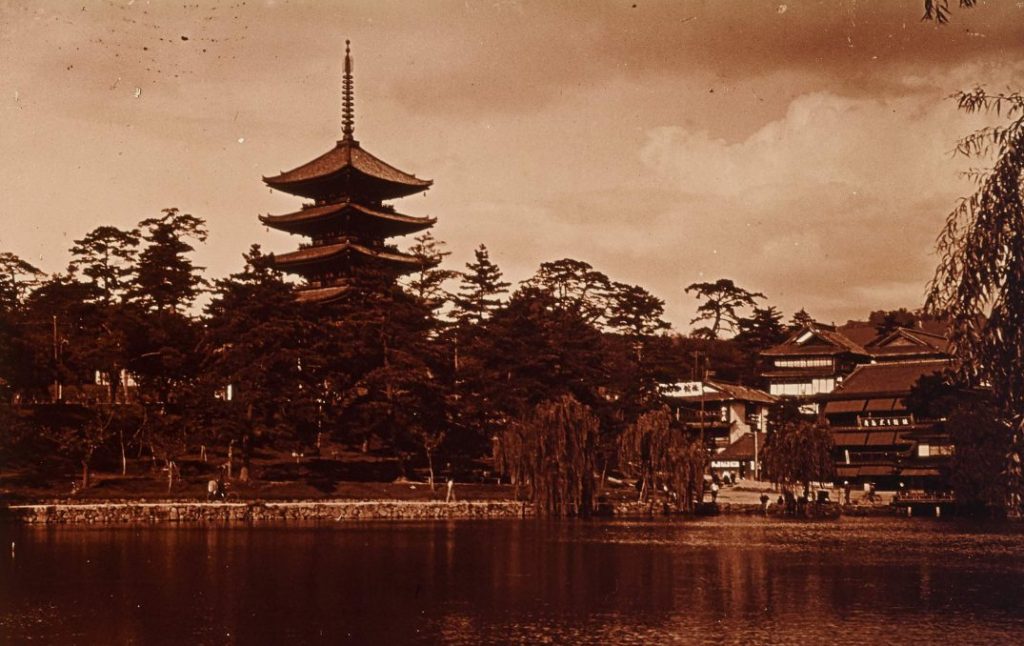
To learn further
- UNE LENTE CONSTRUCTION
- INTERFÉRENCES ET AFFAIRES RELIGIEUSES
- LA RESISTANCE
- L’ACTIVITE DE LA SOCIETE DES MISSIONS ETRANGERES DE PARIS EN CHINE DE 1840 A 1911
- LA GUERRE DES BOXERS
- REVOLTES ET BRIGANDAGES
- TIBET : 1624-1950 LA TERRE INTERDITE
- CHARBONNIER Jean (MEP), « Appendix The MEP in China: A Chronology from the 17th Century to the Present », in Ji LI (dir.), Missions Étrangères de Paris (MEP) and China from the Seventeenth Century to the Present, Leiden / Boston : Brill, Studies in the History of Christianity in East Asia, vol. 6, 2022, p. 245-268 :
BARRIQUAND François & RUELLEN Joseph, Jean Basset (1662-1707), pionnier de l’Eglise au Sichuan, Paris : éd. You Feng, 2012, 742 p.
BRULEY Yves, « Les missionnaires vus par les diplomates français en Chine et au Japon, à l’époque du Second Empire » in La mission en textes et en images, colloque 2003 du GRIEM, dir. Chantal Paisant, Paris : Karthala, 2004, pp. 435-449
CHEN Alexandre Tsung-ming (éd.), Le christianisme en Chine du XIXe au XXIe siècle. Evangélisation et conflits, Leuven : Ferdinand Verbiest Institute, 2013, 328 p.
CHEN Alexandre Tsung-ming (éd.), Le christianisme en Chine du XIXe au XXIe siècle. Figures, événements et missions – œuvres, Leuven : Ferdinand Verbiest Institute, 2015, 261 p.
CHEN Alexandre Tsung-ming (éd.), Le christianisme en Chine du XIXe au XXIe siècle. Catéchèses et formation religieuse, Leuven : Ferdinand Verbiest Institute, 2017, 137 p.
COCO Giovanni, Sante sede e Manciukuo (1932-1945) : con appendice di documenti, Città del Vaticano : Libreria ed. vaticana, 2006.
CHARBONNIER Jean, « Les Missions étrangères en Chine : Tibet – Mandchourie – Hongkong – Taiwan » in Les Missions étrangères en Asie et dans l’océan Indien, Paris : Les Indes savantes, 2007, p. 48-76
CHARBONNIER Jean, Histoire des chrétiens de Chine, Paris : Les Indes savantes, 2002, 426 p.
CHIRON Yves, La longue marche des catholiques de Chine, Paris : Artège, 2019.
DREMEAUX François (dir.), Hong-Kong, présences françaises : du XIXe siècle à nos jours, Hong Kong : Bonham books, 2012
FAUCONNET-BUZELIN Françoise, Les porteurs d’espérance. La mission du Tibet-Sud (1848-1854), Paris : Éditions du Cerf, 1999.
HA Louis (dir.), History of the Catholic religious orders and missionary congregations in Hong Kong, 1-2, Hongkong : Center for Catholic Studies, 2009, 553 p., 753 p.
HA Louis (dir.), History of the Catholic religious orders and missionary congregations in Hong Kong, 3 : Historical materials, Hongkong : Center for Catholic Studies, 2012, 250 p.
LE PICHON Alain, Béthanie et Nazareth : les pères des Missions étrangères à Hong Kong, Hong Kong : the Hong Kong Academy for performing Arts, 2008, 206 p.
LI Ji (dir.), Missions Étrangères de Paris (MEP) and China from the Seventeenth Century to the Present, Leiden / Boston : Brill, Studies in the History of Christianity in East Asia, vol. 6, 2022, 280 p.
RAIGNOUX Rémi / Foreign Missions Society of Paris, France , The South Tibet Mission (1880-1929) and the Prefecture Apostolic of Sikkim-Kalimpong (1929-1937), Kathmandu, 2010, 113 p.
ROUX Pierre-Emmanuel, Persécutions et incidents antichrétiens en Chine pendant la période de proscription du catholicisme (1724-1860), mémoire de DEA, dir. J.-P. Poussou, Paris : Université Paris IV, 2003, 355 p.
SESMAISONS François (de), Un missionnaire breton en Chine au Siècle des Missions : Jean de Guébriant (1860-1935), thèse de doctorat, Paris IV-Sorbonne, 2005, 3 vol.
SIBRE Olivier, « Les séminaires en Chine, entre Église locale et gouvernance romaine, des conférences du père Schmidlin aux défis de la Chine contemporaine » in Le christianisme en Chine du XIXe au XXIe siècle. Catéchèses et formation religieuse, (Ed.) Alexandre Tsung-ming Chen, Leuven : Ferdinand Verbiest Institute, 2017.
SIBRE Olivier, Le Saint-Siège et l’Extrême-Orient (Chine, Corée, Japon). De Léon XIII à Pie XII (1880-1952), Rome : École Française de Rome, 2012.
STANDAERT Nicolas (éd.), Handbook of Christianity in China, 635-1800, Leiden : Brill, 2001, 964 p.
TORCHEBŒUF Marie-Alpais, Œuvrer à la propagation de la foi en Chine et à Rome, Joachim Enjobert de Martiliat (1706-1755) : illustration d’une vie de missionnaire, Thèse pour le diplôme d’archiviste-paléographe, 2012, École nationale des Chartes, 2 vol.
WEBER Anne, Missionnaires et chrétientés en Chine au XVIIIe siècle : l’exemple de la mission du Sichuan (années 1730-1760) autour du journal du prêtre chinois André Li et la correspondance missionnaire, thèse de doctorat sous la dir. de M. Alain Forest, Paris VII, 2010.
WEBER Jacques et SESMAISONS François (de), dir., La France en Chine, 1843-1943, Paris : L’Harmattan, 2013, 265 p.
WEI TSING-SING Louis, Le Saint-Siège et la Chine : de Pie XI à nos jours, Sotteville-lès-Rouen : A. Allais, 1971, 470 p.
XIAO Jieyi, Histoire abrégée de la mission catholique dans le Nord-Ouest du Yunnan (autour de l’église de Cizhong), Tokyo : Institut de recherche sur les langues et les cultures d’Asie et d’Afrique, 2018
YOUNG Ernest P., Ecclesiastical Colony: China’s Catholic Church and the French Religious Protectorate, Oxford : Oxford University Press, 2013, 383 p.
Sources
COSTANTINI Celso (Mgr), Réforme des missions au XXe siècle, Tournai : Casterman, 1960, 280 p.
DESWAZIERES Gustave, La Société des Missions étrangères en Chine de 1880 à 1930, Hongkong : Imprimerie Nazareth, 1930.
ENTENMANN Robert, BARRIQUAND François & RUELLEN Joseph, Sichuan, Journal de Joachim de Martiliat, vicaire apostolique, 1732-1745, Paris : éd. You Feng, 2015, 337 p.
GUÉBRIANT, Jean Budes de (MEP), Nos missionnaires d’Extrême-Orient : une visite aux évêques et prêtres de la Société des Missions étrangères de Paris, Paris : Société Nationale d’Éditions artistiques, 1933.
LAUNAY Adrien (MEP), Monseigneur Verrolles et la mission de Mandchourie, Paris : Téqui, 1895, 446 p.
LAUNAY Adrien (MEP), Histoire des missions de Chine : mission du Kouang-si, Paris : P. Téqui, 1903, 447 p.
LAUNAY Adrien (MEP), Histoire de la mission du Thibet, Paris : Desclée de Brouwer, 1903, 2 vol. (VIII-470 p., 440-19 p.)
LAUNAY Adrien (MEP), Histoire des missions de Chine : mission du Kouy-tcheou, Paris : s.n., 1907-1908, 3 vol. (XXXIX-545 p., 619 p., 534-46 p.)
LAUNAY Adrien (MEP), Histoire des missions de Chine : mission du Kouang-tong, monographie des districts, Paris : P. Téqui, 1917, 207 p.
LAUNAY Adrien (MEP), Histoire des missions de Chine : mission du Se-tchoan, Paris : P. Téqui, 1920, 2 vol. (XXI-662 p., 336-105-21 p.)
Film
SIMONNET Christian (MEP), Hong Kong, incroyable micro-Chine, 1966
Websites
China Historical Christian Database (Boston University)
Institut Ricci (San Francisco) : The Ricci Roundtable
Cartographie (University of Macao / Leiden University) QingMaps
Research Guide for Chinese Studies (Harvard Library)
A. (XVIIe-XVIIe siècles) Premières présences
Avant l’arrivée des MEP
La « querelle des rites chinois »
(1683-1756) Initiatives missionnaires
- Au Fujian
- Au Yunnan
- Au Sichuan
B. (1756-1840) Consolidations au Sichuan et au Yunnan
C. (1840-1950) Une large expansion, du Tibet à la Mandchourie
La période coloniale, charnière pour l’apostolat des MEP
Au Sichuan
Au Yunnan
Au Guizhou
Aux Guangdong et Guangxi
En Mandchourie
Au Tibet
- (1850-1854) Tentative d’exploration du Tibet par le Sikkim
- Echec de la mission du Tibet
Les procures de Hongkong et Macao
- Installation de procures pour faciliter les échanges avec Paris
- L’imprimerie de Nazareth et la maison de repos de Béthanie
L’action de Mgr de Guébriant et l’affirmation d’une diplomatie vaticane
- (1912-1937) Le Vatican et la République de Chine
Transferts des juridictions MEP en Chine à de nouvelles congrégations
Présence MEP en 1936
- (1937-1945) L’action apostolique des MEP pendant la guerre sino-japonaise

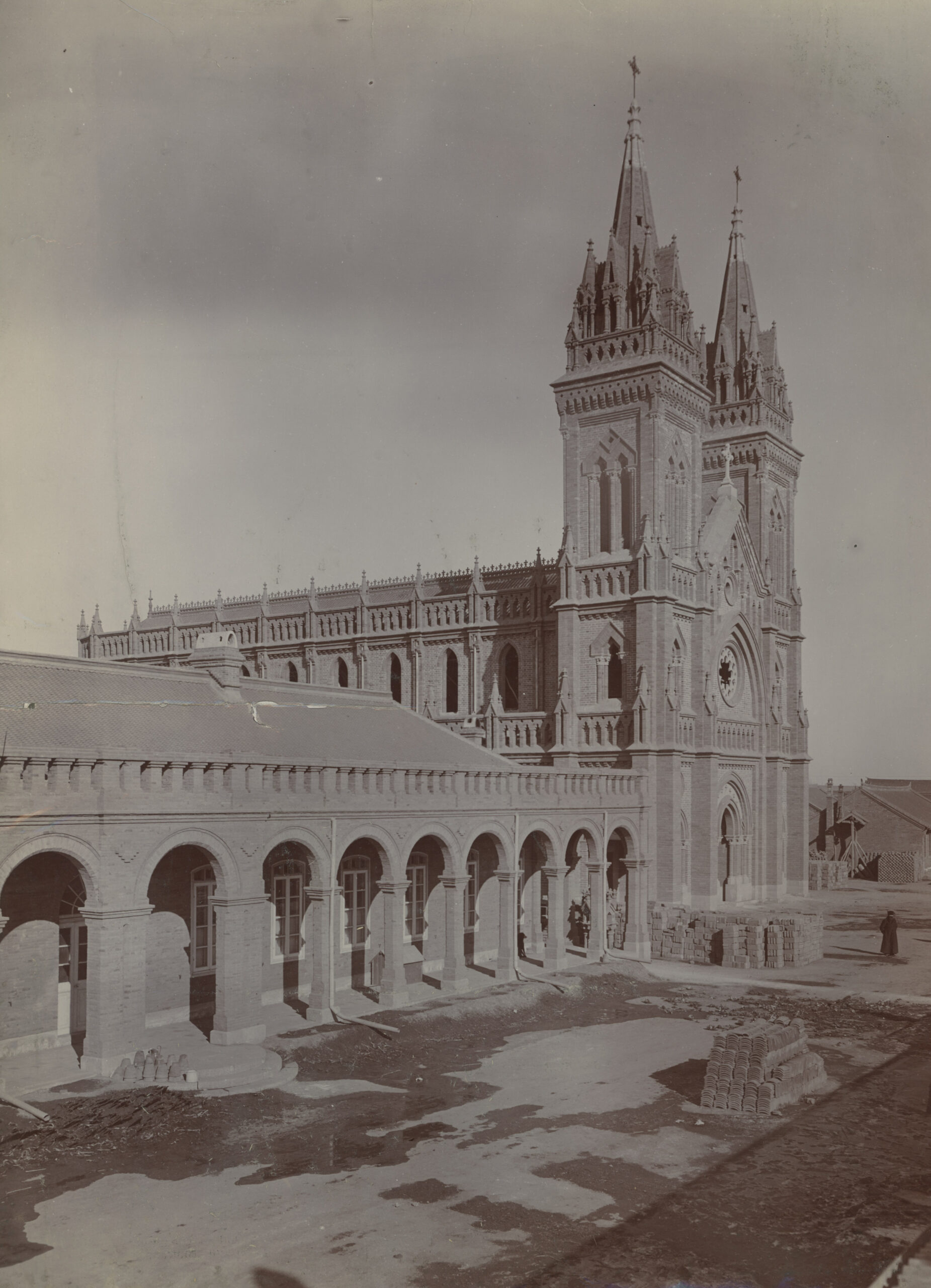
 Download
Download